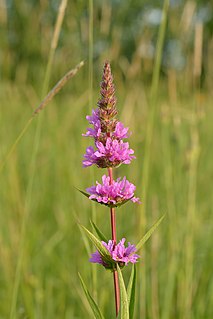
Lythrum salicaria or purple loosestrife is a flowering plant belonging to the family Lythraceae. It should not be confused with other plants sharing the name loosestrife that are members of the family Primulaceae. Other names include spiked loosestrife and purple Lythrum.

Lysimachia is a genus consisting of 193 accepted species of flowering plants traditionally classified in the family Primulaceae. Based on a molecular phylogenetic study it was transferred to the family Myrsinaceae, before this family was later merged into the Primulaceae.
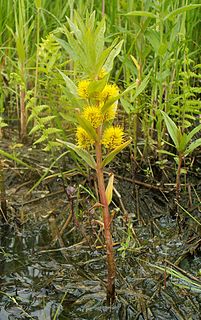
Lysimachia thyrsiflora, the tufted loosestrife, is a plant in the genus Lysimachia. It is native to large sections of the northern Northern Hemisphere, including Eurasia and North America. It often grows in marshes, shorelines of lakes and ponds and occasionally along streams. It is an erect perennial herb growing up to 80 centimeters tall and bearing yellow flowers, sometimes dotted with purple. It may be confused with purple loosestrife when not blooming but can be easily distinguished because purple loosestrife has a square stem. Tufted loosestrife has been used medicinally in Asia to combat high blood pressure.

Ammannia coccinea is a species of flowering plant in the loosestrife family known by several common names, including valley redstem, scarlet toothcup, and purple ammannia. It is native to most of the contiguous United States, with the exception of the Pacific Northwest and New England. It is generally found in moist areas, such as riverbanks and pond margins. It is weedy in some areas. This is an annual herb growing erect to heights approaching one meter or lying along the ground. Leaves are linear in shape, up to 8 centimeters long, and green to shades of deep red in color. The inflorescence is a cluster of 3 to 5 flowers growing in the leaf axils along the upper part of the stem. The rounded flower has small rose to lavender petals each a few millimeters long and protruding stamens with yellow anthers. The fruit is a rounded capsule up to half a centimeter wide containing many tiny seeds.
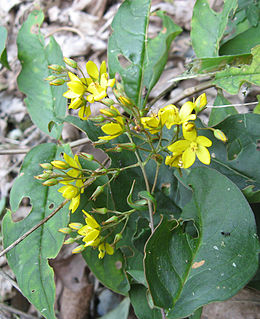
Lysimachia fraseri is a rare species of flowering plant in the primrose family known by the common name Fraser's yellow loosestrife. It is native to the Southeastern United States, where it is listed as an endangered species in several states.

Lythrum californicum is a species of flowering plant in the loosestrife family known by the common name California loosestrife. It is native to northern Mexico and the southwestern United States into the Midwest as far east as Oklahoma and Texas. It often grows in moist habitat. This is an erect perennial herb reaching 20 to 60 cm tall, sometimes branching. The waxy linear to lance-shaped leaves are arranged oppositely lower on the plant, and alternately toward the top. They are 1 to 7 cm in length. The inflorescence is a terminal spike of flowers with purple petals under a centimeter long. Flowers are heterostylous on one individual plant, with some having long, protruding styles and some with shorter styles not protruding from the mouth of the flower. The fruit is an oval capsule containing many minute seeds.
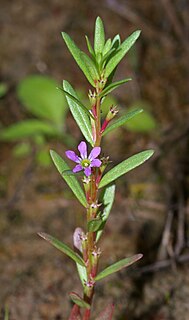
Lythrum hyssopifolia is a species of flowering plant in the loosestrife family known by the common names hyssop loosestrife and grass-poly. It is native to Europe but it is known elsewhere, including parts of Australia and eastern and western North America, as an introduced species and sometimes a weed. It is rare in the United Kingdom, with occasional isolated populations. It often grows in moist habitats, such as marshes and wet agricultural fields, rice paddies, for example.

Lythrum portula is a species of flowering plant in the loosestrife family known by the common names water-purslane and spatulaleaf loosestrife. It is native to Europe, and it is found in parts of western North America as an introduced species. It often grows in moist habitat, such as marshes. This is a prostrate annual herb producing a hairless, reddish stem up to 25 centimeters long which lies along the ground and roots where its nodes come in contact with wet earth. The slightly fleshy, spoon-shaped leaves are about a centimeter long and greenish to reddish in color. Solitary flowers occur in leaf axils. Flowers often have white or pink petals about a millimeter long, but some lack petals. The fruit is a spherical capsule containing minute seeds.
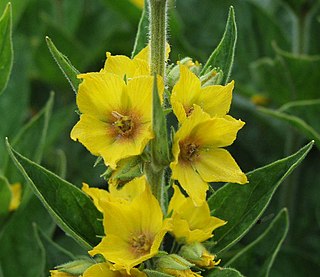
Lysimachia punctata, the dotted loosestrife, large yellow loosestrife, or spotted loosestrife, is a flowering plant species in the family Primulaceae.

Rotala indica is a species of flowering plant in the loosestrife family known by the common name Indian toothcup. It is native to Southeast Asia. This aquatic plant is best known as a popular aquarium plant and as a weed of rice fields. It is known as an introduced species and a weed in rice-growing regions in Congo, Italy, and Portugal, and California and Louisiana in the United States.
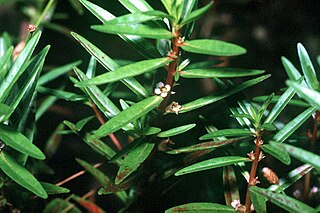
Rotala ramosior is a species of flowering plant in the loosestrife family known by the common name lowland rotala. This aquatic or semiaquatic plant is native to North America, where it grows in lakes, streams, and irrigation ditches. The branching stems of the plant grow to about 40 cm long. Leaves are decussate, arranged oppositely in perpendicular pairs along the stems. The leaves are linear to lance-shaped to oval and up to 5 cm long. Flowers occur singly in leaf axils. Each has triangular sepals with long, narrow appendages and usually four tiny white petals in shades of pink to white. This plant is sometimes grown in aquaria.

Decodon verticillatus, the sole species in the genus Decodon, is a flowering plant in the family Lythraceae. It is commonly known as waterwillow or swamp loosestrife. It is native to wetlands in the eastern half of the United States and Canada.

Lythrum alatum, commonly known as winged loosestrife, winged lythrum or angled purple-loosestrife, is a species of flowering plant belonging to the family Lythraceae. It is endemic to wetland areas in central and eastern United States and Ontario.

Galerucella calmariensis is a species of leaf beetle in the family Chrysomelidae. It is commonly known as the black-margined loosestrife beetle and is native to Europe and Asia where both adults and larvae feed on purple loosestrife. It has been introduced in North America as a biological control agent for purple loosestrife.

Lysimachia asperulifolia is a rare species of flowering plant in the Primulaceae known by the common name rough-leaved loosestrife and roughleaf yellow loosestrife. It is endemic to the Atlantic coastal plain in North Carolina and northern South Carolina in the United States, where there are 64 known populations. It is a federally listed endangered species of the United States.

Lysimachia iniki is a rare species of flowering plant in the family Primulaceae known by the common names Wailua River yellow loosestrife and Wailua River island-loosestrife. It is endemic to Hawaii, where there is only one known occurrence existing on the island of Kauai. The plant was federally listed as an endangered species of the United States in 2010.
Lysimachia pendens is a rare species of flowering plant in the family Primulaceae known by the common name broad-leaf yellow loosestrife. It is endemic to Hawaii, where there is a single occurrence known on the island of Kauai. It was federally listed as an endangered species of the United States in 2010.
Lysimachia scopulensis is a rare species of flowering plant in the family Primulaceae known by the common name shiny-leaf yellow loosestrife. It is endemic to Hawaii, where there are two small populations on the island of Kauai. It was federally listed as an endangered species of the United States in 2010.
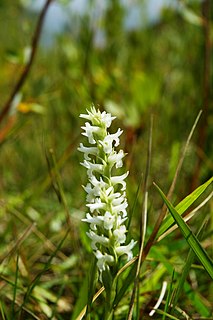
Spiranthes diluvialis is a rare species of orchid known as Ute lady's tresses. The species name diluvialis means "of the flood". It is native to the western United States, where there are scattered, mostly small occurrences in the states of Colorado, Idaho, Montana, Nebraska, Nevada, Utah, Washington, and Wyoming. An occurrence was recently discovered in southern British Columbia. The plant faces a number of threats to its existence. It is a federally listed threatened species of the United States.
Cuphea aspera is a species of flowering plant in the loosestrife family known by the common names tropical waxweed and Chapman's waxweed. It is endemic to Florida in the United States, where it is limited to Gulf and Franklin Counties on the central Florida Panhandle. It has likely been extirpated from Calhoun County.

















